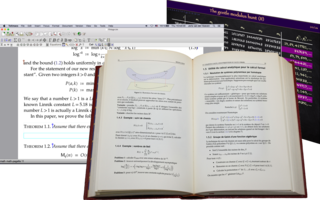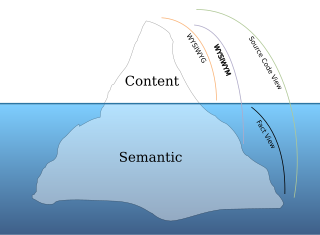
Microsoft Word is a word processing software developed by Microsoft. It was first released on October 25, 1983, under the name Multi-Tool Word for Xenix systems. Subsequent versions were later written for several other platforms including IBM PCs running DOS (1983), Apple Macintosh running the Classic Mac OS (1985), AT&T UNIX PC (1985), Atari ST (1988), OS/2 (1989), Microsoft Windows (1989), SCO Unix (1990), and macOS (2001).

A word processor is an electronic device for text, composing, editing, formatting, and printing.
In computing, WYSIWYG, an acronym for What You See Is What You Get, is a system in which editing software allows content to be edited in a form that resembles its appearance when printed or displayed as a finished product, such as a printed document, web page, or slide presentation. WYSIWYG implies a user interface that allows the user to view something very similar to the end result while the document is being created. In general, WYSIWYG implies the ability to directly manipulate the layout of a document without having to type or remember names of layout commands.
Desktop publishing (DTP) is the creation of documents using page layout software on a personal ("desktop") computer. It was first used almost exclusively for print publications, but now it also assists in the creation of various forms of online content. Desktop publishing software can generate layouts and produce typographic-quality text and images comparable to traditional typography and printing. Desktop publishing is also the main reference for digital typography. This technology allows individuals, businesses, and other organizations to self-publish a wide variety of content, from menus to magazines to books, without the expense of commercial printing.
QuarkXPress is a desktop publishing software for creating and editing complex page layouts in a WYSIWYG environment. It runs on macOS and Windows. It was first released by Quark, Inc. in 1987 and is still owned and published by them.

Ventura Publisher was the first popular desktop publishing package for IBM PC compatible computers running the GEM extension to the DOS operating system. The software was originally developed by Ventura Software, a small software company founded by John Meyer, Don Heiskell, and Lee Jay Lorenzen, all of whom met while working at Digital Research. It ran under an included run-time copy of Digital Research's GEM.
An HTML editor is a program for editing HTML, the markup of a web page. Although the HTML markup in a web page can be controlled with any text editor, specialized HTML editors can offer convenience and added functionality. For example, many HTML editors handle not only HTML, but also related technologies such as CSS, XML and JavaScript or ECMAScript. In some cases they also manage communication with remote web servers via FTP and WebDAV, and version control systems such as Subversion or Git. Many word processing, graphic design and page layout programs that are not dedicated to web design, such as Microsoft Word or Quark XPress, also have the ability to function as HTML editors.

LyX is an open source, graphical user interface document processor based on the LaTeX typesetting system. Unlike most word processors, which follow the WYSIWYG paradigm, LyX has a WYSIWYM approach, where what shows up on the screen roughly depicts the semantic structure of the page and is only an approximation of the document produced by TeX.

GNU TeXmacs is a scientific word processor and typesetting component of the GNU Project. It was inspired by TeX and GNU Emacs, though it shares no code with those programs. TeXmacs does use TeX fonts. It is written and maintained by Joris van der Hoeven and a group of developers. The program produces structured documents with a WYSIWYG user interface. New document styles can be created by the user. The editor provides high-quality typesetting algorithms and TeX and other fonts for publishing professional looking documents.

Typesetting is the composition of text by means of arranging physical type or its digital equivalents. Stored letters and other symbols are retrieved and ordered according to a language's orthography for visual display. Typesetting requires one or more fonts. One significant effect of typesetting was that authorship of works could be spotted more easily, making it difficult for copiers who have not gained permission.
Adobe InDesign is a desktop publishing and page layout designing software application produced by Adobe Inc. It can be used to create works such as posters, flyers, brochures, magazines, newspapers, presentations, books and ebooks. InDesign can also publish content suitable for tablet devices in conjunction with Adobe Digital Publishing Suite. Graphic designers and production artists are the principal users, creating and laying out periodical publications, posters, and print media. It also supports export to EPUB and SWF formats to create e-books and digital publications, including digital magazines, and content suitable for consumption on tablet computers. In addition, InDesign supports XML, style sheets, and other coding markup, making it suitable for exporting tagged text content for use in other digital and online formats. The Adobe InCopy word processor uses the same formatting engine as InDesign.

In computing, What You See Is What You Mean is a paradigm for editing a structured document. It is an adjunct to the better-known WYSIWYG paradigm, which displays the result of a formatted document as it will appear on screen or in print—without showing the descriptive code underneath.
Copy editing is the process of revising written material to improve readability and fitness, as well as ensuring that text is free of grammatical and factual errors. The Chicago Manual of Style states that manuscript editing encompasses "simple mechanical corrections through sentence-level interventions to substantial remedial work on literary style and clarity, disorganized passages, baggy prose, muddled tables and figures, and the like ". In the context of print publication, copy editing is done before typesetting and again before proofreading. Outside traditional book and journal publishing, the term copy editing is sometimes incorrectly referred to as proofreading, or the term copy editing sometimes includes additional tasks.
The Quark Publishing System (QPS) was a collaborative workflow management system first released in 1991 by Quark, Inc. and now superseded by Quark Publishing Platform. It allowed the creators of large publications to manage the process by which the publications are created, and also track the flow of created materials through the various phases of creation, editing, review, combination, and printing. It was mostly used by the producers of periodical publications like magazines, newspapers and catalog but also occasionally used for producing complicated one-off publications like books and advertising materials.

In graphic design, page layout is the arrangement of visual elements on a page. It generally involves organizational principles of composition to achieve specific communication objectives.
Adobe InCopy is a professional word processor made by Adobe Inc. that integrates with Adobe InDesign. While InDesign is used to publish printed material, including newspapers and magazines, InCopy is used for general word processing. The software enables editors to write, edit, and design documents. The software includes standard word processing features such as spell check, track changes, and word count, and has various viewing modes that allow editors to visually inspect design elements — just as it looks to the designer working in Adobe InDesign.
Screenwriting software are word processors specialized to the task of writing screenplays.

InPage is a word processor and page layout software for languages such as Urdu, Balochi, Persian, Pashto and Arabic under Windows and Mac which was first developed in 1994. It is used for creating pages in the language of Urdu, using the Nasta`līq (نستعلیق) style of Arabic script.
MathMagic is a mathematical WYSIWYG equation editor, available for Windows, macOS, Android and iOS since its debut in 1998. MathMagic is known for its DTP quality equations and widely used by Adobe InDesign and QuarkXPress users. MathMagic is a stand-alone multi-purpose equation editor application so its equation can be used by most software, such as word processors, presentation software, DTP layout software, and graphic software, via Copy and Paste, Drag and Drop, or by exporting to one of its supported formats.